Renewable Energy Prepares For Great Budget Push
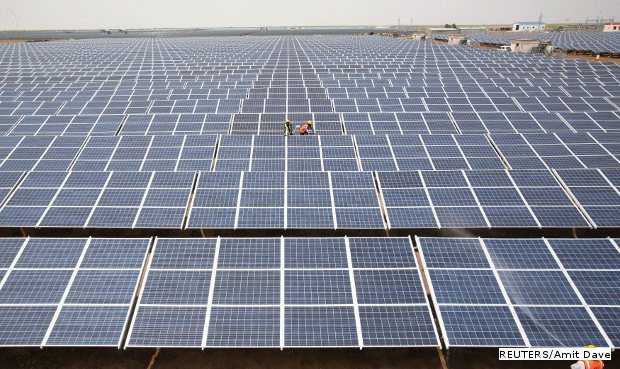
“Power To all” is a mantra used by the National Democratic Alliance (NDA) government, and Prime Minister Narendra Modi recently spoke about the “seven horses” of energy, adding renewable energy sources—solar, wind and biomass—to the present energy mix of thermal, gas, hydro and nuclear.
The potential is enormous.
India has a renewable energy potential of about 895 giga watts (GW)—that is nearly three-and-a-half times India’s entire installed capacity, as of last month. Solar power alone could generate 750 GW. (One GW is 1,000 mega watts (MW), or a billion watts.)
However, as IndiaSpend previously reported, solar power at 2.6 GW contributes to less than 1% of country’s electricity demand of 254 GW.
Let us look at India’s renewable energy mix in terms of installed power capacity.
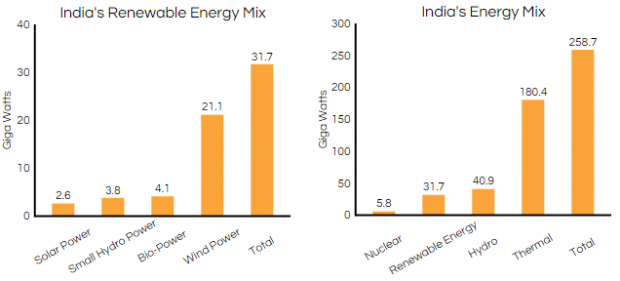
Source: Ministry of Power; Figures as on Jan 31, 2015; Figures for Renewable Energy as on 31.03.2014
India’s renewable energy contribution stands at 31 GW of installed power capacity, compared to 18 MW in 1990.
Renewable energy now accounts for 12% of India’s total power installed, which is 258 GW.
India is the world’s fifth-largest producer of wind energy, with a capacity of 21.1 GW.
Wind energy is the largest contributor to India’s renewable energy mix in terms of total installed capacity with a 66% share. Solar energy contributes 8% to total renewable energy capacity.
Thermal power with 70% share still dominates India’s energy mix.
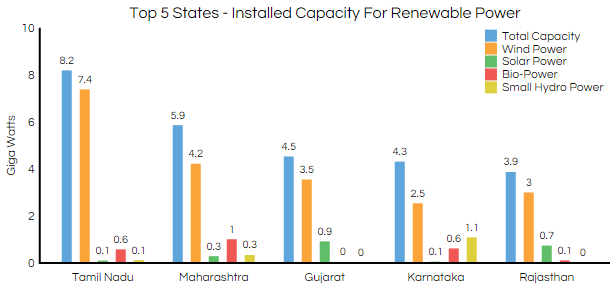
Source: Lok Sabha; Figures as on Oct. 31, 2014; Figures in GW
Tamil Nadu with an installed capacity of 8.1 GW in renewable energy tops the list, followed by Maharashtra and Gujarat.
One reason for the success of these states is that they are also leading producers of wind energy. Tamil Nadu has an installed capacity of 7.3 GW, followed by Maharashtra and Gujarat.
In solar power, Gujarat ranks first with 0.9 GW installed capacity, followed by Rajasthan and Madhya Pradesh.
The government has allowed 100% foreign direct investment (FDI) for renewable energy generation and distribution projects. The FDI inflow was $2.5 billion from April 2000 to February 2013. This is expected to increase in the near future with government trying to attract more investment and manufacturers.
Around the world, renewables power up
Renewable energy sources accounted for 10% of global energy consumption and around 19% of global electricity needs in 2013.
| Countries | Wind | Solar PV | Bio-power | Others* | Total |
| China | 91 | 19.9 | 6.2 | 0 | 118 |
| United States | 61 | 12.1 | 15.8 | 4.3 | 93 |
| Germany | 34 | 36 | 8.1 | 0 | 78 |
| Spain | 23 | 5.6 | 1 | 2.3 | 32 |
| Italy | 8.6 | 17.6 | 4 | 0.9 | 31 |
| India | 20 | 2.2 | 4.4 | 0.1 | 27 |
| EU-28 | 117 | 80 | 35 | 3.5 | 235 |
| BRICS | 115 | 21 | 24 | 0.2 | 162 |
| World | 318 | 139 | 88 | 15.9 | 560 |
The global renewable power capacity was 560 GW in 2013, of which China’s was 118 GW, or 21%. One of the reasons for China’s top position is its share of wind power capacity at 91 GW.
India is ranked 6th with 27 GW total installed capacity, contributing less than 5% of total global capacity.
In solar power, Germany with 36 GW installed capacity ranks first, followed by China (19.9 GW) and the United States (12.1 GW). India’s 2.2 GW does not make it to the list of top 10 countries.
The European Union’s share of global renewable power capacity is declining as the market expands outside the EU.
The new government loves renewables
The NDA government, in its maiden budget last July, increased the allocation towards renewable energy by 118% over the 2013-14 budget of the previous government.
Let us look at the budget allocations for the past 10 years.
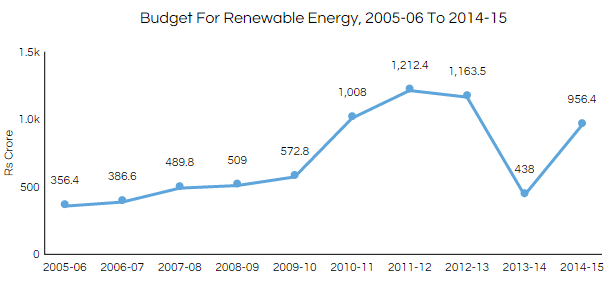
Source: Union Budget; NA – Not Available; Note: *2014-15 figures are budget estimates
The budget allocation indicates a jump of almost 100% between 2009-10 and 2012-13.
The revised figures indicate how ministry expenses for renewable energy shot up 226% from Rs. 356.4 crore in 2005-06 to Rs 1,163.4 crore in 2012-13. However, the decline of 62% from Rs 1,163.4 crore in 2012-13 to Rs 437.9 crore in 2013-14 could indicate a disinterest by the previous government during its last term.
The government, through its ‘Make In India’ initiative, is also trying to promote manufacturing of renewable energy equipment. The government plans to promote ‘solar entrepreneurs’ and boost jobs under the skill-development programme.
The Ministry of New and Renewable Energy intends to set up a team of 50,000 ‘Urja Mitra’ (Energy Friends), by roping in educational and training institutions over the next five years.
President Pranab Mukherjee, while addressing the joint session of the Parliament on recently, also referred to the government’s clean-energy efforts. “The share of renewable energy in electricity generation is being significantly enhanced from 6% to 15% of the energy mix in the next seven years,” President Mukherjee said.
It is now time to see if the government will walk its renewable talk.
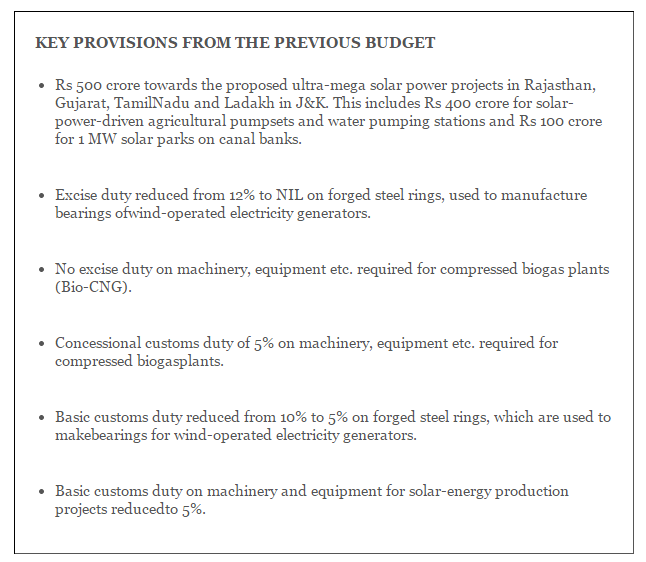
Source: Make in India
____________________________________________________________
“Liked this story? Indiaspend.org is a non-profit, and we depend on readers like you to drive our public-interest journalism efforts. Donate Rs 500; Rs 1,000, Rs 2,000.”


